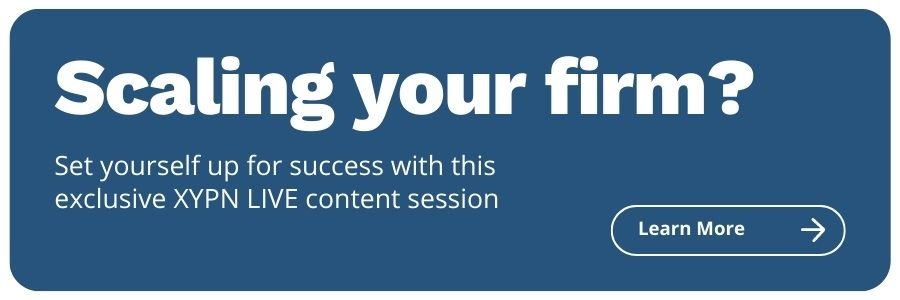Hiring? Your Guide to Creating a Positive Employee Onboarding Experience
Share this
Are you still hiring or already onboarding? And no, onboarding is not referring to boarding the plane to your next vacation adventure you certainly earned. The term onboarding refers to the full integration of a new employee into the workplace. Subsequently, the onboarding experience of a new hire should not be limited to completing the required documentation of an I-9, W-4, and benefits enrollment. Onboarding means integrating the new hire into your workplace culture and understanding your firm’s mission, vision, and values. It’s also about making connections with the team.
As a small firm owner, you might ask if it will be worthwhile to spend more time and resources toward onboarding your new hires. Well, research shows that 69% of employees are more likely to stay with a company for three years if they received a great onboarding experience. New employees who received structured onboarding were 58% more likely to stay, and firms with a standard onboarding process experience achieve 50% greater new hire productivity. Since turnover costs are usually calculated as one-third (⅓) of annual salary, anything that helps retention is helping the bottom line.
Ok, so a well-structured and well-done onboarding plan is essential. How do we deliver?
Lay the foundation with a preboarding process
Let’s start with Preboarding. Preboarding refers to any interaction between you and your new hire before their start date. Preboarding can fill gaps between an accepted job offer and the actual start date in ensuring the hire stays engaged with the firm while the firm starts welcoming a new team member. The most important pitfall to avoid during this time is to assign formal training and complete new hire paperwork too early. Any required training and the completion of required paperwork is usually viewed as compensable time and therefore should take place after the new team member has officially started.
However, welcome emails and other helpful information for the first day are always appreciated. Things of that nature include:
-
Directions to the office (if the new hire is unfamiliar with the area)
-
Parking instructions
-
Itinerary of their first day/first week of onboarding
-
Benefits Guide
-
An invitation for a casual lunch on their first day
-
Welcome packet with company swag
If you have any big company events that take place just before the new hire starts, consider sending an invitation their way. Just be sure to highlight that their attendance is voluntary, and do not be offended if the new hire has to decline. Usually changing jobs comes with a lot of moving pieces for team members which can take up considerable time on their calendar.
The start date is here—let's onboard!
When the start date of the new team member has finally come you can launch the full Onboarding process.
A good place to start is to create an onboarding checklist to make the process and itinerary transparent to the new team member and to ensure a standardized onboarding process. There are plenty of examples on the internet, including these resources from Indeed and Forbes. Feel free to get some inspiration before tailoring a checklist to your firm’s needs. Aside from the usual items such as a tour of the facility, introductions, and HR paperwork, true employee onboarding includes learning about the mission and vision of the company as well as an introduction to the company culture.
In other words: tell your firm's story. Who are you? Why do you exist? What is your niche and why? What are your firm's goals for the next year and the next 5 years?
Explain the role the new team member will play within the firm and how it relates to the firm's overall strategy. Go over specific job duties and expectations as well as measurables for success in the role. Also, let the new team member know who can answer any topic and subject-related questions.
When you onboard the new employee into the company culture answer questions like:
How do we connect with each other? When do we write an email and when do we use a messaging system such as Slack to communicate? What language does the firm use to engage with clients? Formal? More informal? Do you use emojis? GIFs? Is everyone bringing their dog to work or is that the most frowned-upon thing to even consider?
Also, encourage and facilitate connections between the new team member and the team. Going out to lunch or another engaging team activity can serve as an icebreaker to introduce and welcome the new team member.
Another helpful tool to onboard new team members is to create a 30-60-90 day plan. This plan will outline training objectives within the first 3 months of employment. Again, there are many examples and guides to get you started, including examples from Forbes and Asana, or view our blog on 30-60-90 day plans. Subsequently, we should check-in with new team members periodically. At first, I would recommend a check-in meeting every month, after the 90-day plan is completed, and then another check-in at the 6-month mark, followed by the 1-year mark.
Last but not least, consider a mentoring or buddy system for new hires. Mentors and buddies are usually volunteers that ideally consist of recent hires since they can help the new hire understand what has helped them the most. Generally, a mentor or buddy is not within the reporting structure of the new hire and not acting in an official capacity. Mentors and buddies will guide the new team member through cultural nuances and practical questions. For example, how formal are company events? How do I purchase office supplies?
With all that in mind, onboarding processes vary and will require a unique approach based your individual firm's needs and values. Just remember not having an onboarding plan is not an option if you are planning to retain new team members, and you will never get a second chance to make a first impression.

About the Author
Stephanie Bogison is XYPN’s Director of Talent on the People and Culture team. Her passion for connecting (the right) people with their next job opportunity is contagious. When she isn’t finding awesome talent for XYPN, Stephanie spends her time with her family — kids in tow — enjoying the great Montana outdoors.
Share this
- Fee-only advisor (381)
- Advice (305)
- Business Development (248)
- Independent Financial Advisor (203)
- Growing Your Firm (161)
- Marketing (133)
- Financial Planning (129)
- What Would Arlene Say (WWAS) (81)
- Business Coach (80)
- Firm Ownership (78)
- Training (75)
- Compliance (72)
- Business (69)
- Building Your Firm (65)
- Financial Advisors (63)
- Online Marketing (61)
- Events (59)
- Starting a Firm (52)
- Staffing & HR (49)
- Technology (49)
- From XYPN Members (48)
- Launching a firm (46)
- Advisors (41)
- Entrepreneurship (38)
- Taxes (37)
- Networking & Community (33)
- Interviews and Case Studies (32)
- Investment Management (31)
- Sales (27)
- Social Responsibility (27)
- Tax Preparation (27)
- XYPN Invest (26)
- Business Owner (25)
- Small Business Owner (20)
- Financial Management & Investment (19)
- Industry Trends & Insights (19)
- Financial Education (17)
- Financial Planners (17)
- Independent Financial Planner (17)
- Tech Stack (17)
- XYPN (17)
- Leadership & Vision (16)
- Investing (15)
- Niche (15)
- How to be a Financial Advisor (14)
- NextGen (14)
- RIA (14)
- Media (13)
- Preparing to Launch (13)
- Press Mentions (13)
- RIA Operations (12)
- RIA Owner (12)
- XYPN Membership (12)
- Assets Under Management (AUM) (11)
- First Year (11)
- Goals (11)
- Scaling (10)
- Advisor Success (9)
- Building Your Firm (8)
- Communication (8)
- Lessons (8)
- Study Group (8)
- Time Management (8)
- Virtual Advisor (8)
- Behavioral Finance (7)
- Growth (7)
- Pricing Models (7)
- From Our Advisors (6)
- Independent RIA (6)
- Money Management (6)
- Motivation (6)
- Processes (6)
- Automation (5)
- Broker-Dealers (5)
- College Planning (5)
- Filing Status (5)
- How I Did It series (5)
- Investment Planner (5)
- Mental Health (5)
- Michael Kitces (5)
- Preparing to Launch (5)
- RIA Operations (5)
- Retirement (5)
- Risk and Investing (5)
- S Corpration (5)
- Support System (5)
- TAMP (5)
- Wealth (5)
- Year-End (5)
- Client Services (4)
- Outsourcing (4)
- Selling a Firm (4)
- Succession Plans (4)
- Benchmarking Study (3)
- Budgeting (3)
- Career Changers (3)
- Engagement (3)
- Fiduciary (3)
- Getting Leads (3)
- Membership (3)
- Millennials (3)
- Monthly Retainer Model (3)
- Partnership (3)
- Pricing (3)
- Recordkeeping (3)
- Risk Assessment (3)
- Small Business (3)
- Staying Relevant (3)
- Work Life Balance (3)
- Advice-Only Planning (2)
- Bookkeeping (2)
- Charitable Donations (2)
- Client Acquisition (2)
- Differentiation (2)
- Health Care (2)
- IRA (2)
- Inflation (2)
- Productivity (2)
- Implementing (1)
Subscribe by email
You May Also Like
These Related Stories

Your Best ROI: Engaged, Happy Employees (Exclusive XYPN LIVE Content)

Employer-Sponsored Childcare: The Story Behind XY Learning Center





